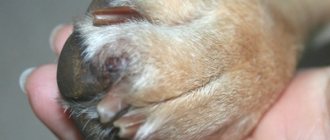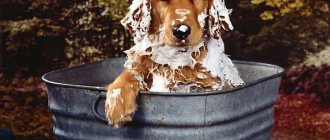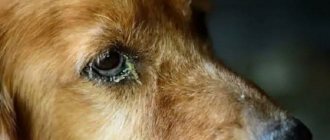Toxocariasis is a type of helminthiasis, a parasitic infection caused by the helminths Toxocara canis and Toxocara mystax, which live in the bodies of wild and domestic dogs and cats, respectively. The larvae enter the soil with animal feces, where they continue to develop. Therefore, the route of transmission of infection is fecal-oral, the most common among children. You can become infected through unwashed hands after interacting with these animals, working in garden plots, children's games in sandboxes, as well as eating unwashed fruits and vegetables, onto which Toxocara larvae can fall along with the soil.
General information about worms in dogs
Parasitic worms have gone through millions of years of evolution and are ideally adapted to exist at the expense of host organisms. They try to behave as inconspicuously as possible. Their presence becomes obvious if the worms in the body have multiplied greatly and intoxication occurs with the products of their vital activity. The rest of the time, the parasites quietly poison the dog. Helminths in a dog can penetrate not only the digestive system, but also the lungs, liver, brain, and other organs.
The waste products of worms poison the entire body, causing allergic reactions. Parasites consume nutrients that enter the animal's body, which weakens the dog and leads to exhaustion. A dog infected with worms is susceptible to diseases and infections. In puppies there is a delay in growth and development; worms cause intestinal obstruction.
There are three main groups of parasitic worms: flatworms, roundworms and flukes. They cause diseases such as cestodosis, nematodosis and trematodosis. In Russia, dipylidioses (a group of cestodes), toxocariases and toxascariases (a group of nematodes) are often diagnosed. More than 80 species of worms can live in an animal’s body, of which more than 30 species are dangerous to humans (ascariasis).
Reviews
Mikhail, veterinarian, Tomsk:
“The use of traditional medicine in the treatment of helminths in dogs can only help in mild cases, when the disease has just appeared and is not burdened by additional health problems.
In acute forms of the disease, the animal must be treated strictly with special medications and only after examination by a veterinarian. Otherwise, there is every risk of complicating the disease and leading to death of the pet.”
Anna, Saratov:
“The husky has worms. Fortunately, from all the symptoms it was clear that the disease was just beginning: the dog began to eat less, walked backwards on the floor, and lost weight.
Pumpkin seeds helped us. I crushed them with a blender and added them to dry food for a month. After this treatment, the animal stopped suffering from parasites, and its appetite and activity returned.”
Sergey, Yekaterinburg : “The German shepherd was diagnosed with helminthiasis. They didn’t want to poison her with chemicals, they tried to start treatment with folk remedies. We tortured the animal for two weeks, tried both garlic and fasting. It only got worse. I had to turn to veterinary drugs and treat the animal according to all the rules.”
Reasons for appearance
Infection with parasites occurs constantly. Since many worms are dangerous to humans, it is important to promptly treat your pet and carry out prevention. The main causes of parasites:
- Fleas. If your pet has them, veterinarians always recommend giving anthelmintics. Fleas carry flatworms. When a pet licks its fur, it often swallows insects, along with which worms enter the intestines.
- Pregnancy. Parasites often reach the puppy from the mother, and infection occurs in the womb. Worms can “move” to the baby during feeding. Before mating, a responsible owner deworms the female so that the puppy does not have problems.
- Dirt. Worm eggs are often found in soil, sand, or puddles.
- Stray dog feces.
- Raw meat.
Danger to humans
A dog or puppy with worms, when interacting with a person, can infect him with helminthiasis. The larvae and eggs of parasites leave the animal's body in the feces. They can attach to the pet's fur, bedding or toys, and then end up in the owner's hands.
Due to the difference in body temperature, not all dog worms can live in the human body. But some of them can cause dangerous diseases.
- Toxocara canis. The larvae migrate through the human circulatory system, settling in various organs. As a result, ocular or visceral toxocariasis develops. It affects the lungs, liver, eyes, and central nervous system.
- Echinococcus granulosus. The larvae of this helminth are extremely dangerous for the human body, although they cannot develop in it. They migrate throughout the body and settle in the lungs, forming a cyst. The neoplasm causes coughing and chest pain.
- Echinococcus multilocularis. The larvae of this tapeworm settle in the human liver and also form a cyst. When a secondary infection occurs, jaundice, abscess, and cirrhosis of the liver develop.
- Coenurus cerebralis. The larvae of such worms look like a water bubble. They settle in the area of the spinal cord or brain. Depending on the location of the lesion, a person suffers from migraines, seizures, and decreased vision.
- Dipylidium caninum. The tapeworm takes root in the human intestine, develops, grows, and reproduces. As a result, the patient suffers from diarrhea, skin rash, and abdominal pain.
Timely deworming and proper personal hygiene will help avoid the development of these diseases.
Signs
Many owners do not know how to determine the presence of parasites in an animal, making it difficult to treat worms in dogs. There are a number of signs that indicate the presence of worms in a pet:
- Puppies are inactive and lethargic. Their growth slows down. The cub's fur becomes matte, and the white of the eye acquires a bluish rim. The abdomen is swollen, the stomach is rumbling.
- The pet loses weight (even with a normal appetite); vomiting, diarrhea, and hiccups may occur after eating. If there are already a lot of worms, then the pet refuses to eat, and the immune system weakens.
- The mucous membranes become pale, and skin diseases and dermatitis may appear.
- Worms are noticeable in the animal's feces, blood and mucus appear. Parasites often cause constipation.
- The liver enlarges.
- Wandering larvae can injure lung tissue, which can lead to pneumonia.
- Car loan for a new car without a down payment
- Pityriasis rosea in humans - symptoms and signs, what it looks like in people, photos
- Mackerel baked in the oven, stuffed. Detailed recipes with photos
Cutaneous form
In this form, dirofilariasis in dogs occurs quite often, and in most cases it is discovered by chance. One can easily mistake a lump or knot under the skin for an abscess, abscess, atheroma or tumor, or cyst, since such a formation does not reveal its origin until it is opened.
After the doctor cleans the wound and removes the worm, its habitat is disinfected and usually heals without a trace. It is imperative to use drug therapy in order to destroy possible larvae - microfilariae, which can give rise to new formations under the skin.
Up to half of all cases of skin formations occur in the eye area. The pest can settle under the skin of the eyelids, conjunctiva or mucous membrane, sometimes it even lives in the eyeball itself. This is a complex pathology that will require special skill and care from the surgeon when removing the parasite.
Principles of treatment of worms in dogs
The veterinarian should recommend an anthelmintic drug for the pet based on age. Many modern drugs are universal, low-toxic and well tolerated by animals. You should purchase medications from veterinary pharmacies or special departments of pet stores. It is better to give puppies and small breed dogs not a tablet, but a suspension, pouring it in with a syringe. There are also drops for the withers, but they are not suitable for puppies, pregnant bitches and weakened animals. Basic principles of treatment:
- It is better to treat adult dogs of medium and large breeds with tablets, since the dosage is easy to calculate.
- The tablet should be given on an empty stomach. The dose is calculated based on body weight. The suspension is poured into the throat using a dispenser syringe. You can feed your pet two hours after taking the medicine.
- Treatment of dogs for worms will be effective if you use modern drugs, they are used once. Repeating is recommended after 2-3 weeks to destroy the grown larvae.
- The dosage of tablets for prevention is calculated by the veterinarian. Medicine against worms is given from three weeks of age, and tablets are given again every six months. It is important to rid your dog of fleas first. Deworming is carried out two weeks before vaccination.
- During the treatment period, the animal may feel unwell because the body is poisoned by toxins from dead parasites. To reduce the negative effect, during and after taking the tablet, give your pet a sorbent (activated carbon) and a hepatoprotective agent.
- If the animal does not show signs of infection and looks good, then it is better to limit itself to preventive measures (give a tablet once every six months).
- All animals living in the same area will need treatment for worms. Owners should also take an anthelmintic tablet.
Nutrition against parasites
Starvation
The simplest and most effective way to kill helminths is to treat the dog with fasting. To do this, the pet should not receive any food for 24 hours once a week. The method is based on the fact that when deprived of food, the worms weaken and cannot adhere to the intestinal walls.
Important. Before using such a radical method, you must consult a veterinarian for advice so as not to harm the animal.
How to feed?
Another simple and effective way is a dog diet. To rid an animal of parasites, you should exclude from the diet foods that worms especially like.
The dog temporarily does not need to be fed eggs, milk, sweet and fatty foods. Only after the final removal of helminths can the animal eat as before.
Deworming drugs
If the worms have already entered the animal’s body and are actively spreading in the intestines, then action must be taken immediately. The veterinarian will help you choose a remedy for worms in dogs. The following positions deserve special attention:
- Drontal. Available in the form of tablets and suspensions. The first are of two types - for puppies and small breed dogs (per 10 kg of weight), for animals weighing more than 35 kg. The tablets are produced in the form of a stone.
- Prazitel. Available form: tablets and suspension. An anthelmintic suitable for fighting worms. The dose is calculated based on the weight of the animal.
- Helminthal. The drug rarely causes adverse reactions. Available form: suspension or droplets on the withers (from parasites living on the fur). The medicine is not prescribed to collies, shelties and bobtails; these breeds do not tolerate it well.
- Droncite. Available form: tablets, solution for injection. The drug is safe for pregnant bitches and non-toxic for puppies.
- Milbemax. The tablets are suitable for treating gastrointestinal parasites and come in two types – for puppies and small breeds and large dogs. Causes side effects in collies and shelties.
How is heart dirofilariasis diagnosed?
Further diagnostic tests are needed to determine whether the dog can safely undergo treatment for the disease. Some of the following diagnostic procedures are recommended before starting treatment:
Serological test for antigens of adult helminths (antigen ELISA test or SNAP test).
This test is performed on a blood sample.
The most widely used test is one that detects antigens produced by adult worms.
This is the most widely used test as it detects antigens (proteins) produced by adult worms. It can be positive even if there are no microfilariae in the dog's blood (about 20% of cases). Dogs with fewer than five adult worm burdens may not produce enough circulating antigen to test positive, so dogs with low parasite burdens or early stages of infection may test negative by chance. Since only antigen produced by females can be detected, if there are males in the body, the results will also be negative. Therefore, there must be at least 4-5 female individuals to obtain a positive test result.
Blood test for the presence of microfilariae (microscopic examination or Knott test):
The blood sample is examined under a microscope for the presence of microfilariae.
The blood sample is dehydrated and then examined under a microscope for the presence of microfilariae. If microfilariae are visible, the test is positive. The number of microfilariae gives a general idea of the extent of the infection. However, microfilariae will be found in the blood in greater numbers during the summer months and in the evening, so the timing of sampling may affect this test. About 20% of dogs test negative even if they have heartworms. This occurs because the immune system has acquired the ability to destroy microfilariae. Additionally, there are other blood parasites that are quite common in dogs and can be difficult to distinguish from heartworm larvae. For these reasons, the antigen test is the preferred diagnostic test.
Other blood tests:
detailed clinical blood test, biochemical blood test, electrolytes. Abnormalities in clinical and biochemical blood tests may indicate the presence of heart dirofilariasis. These tests are performed on dogs that have been diagnosed to determine the dog's organ function and health status before treatment begins.
Radiograph (x-ray):
A dog with heartworms will typically show an enlarged heart and swelling of the large artery (pulmonary artery) leading from the heart to the lungs. These signs are thought to be signs of heartworm disease. An x-ray will also help understand the condition of the heart, lungs and pulmonary vessels. This information allows one to predict an increased risk of treatment-related complications.
Electrocardiogram (ECG):
monitors the electrical current generated by the heart. This is the most useful option for determining the presence of abnormal heart rhythms. This test can also detect enlarged heart chambers and help determine whether the dog can safely undergo treatment for the condition.
Echocardiography (ultrasound of the heart):
shows the chamber of the heart and allows you to assess the general condition of the heart. Heartworms may also be seen.
Traditional medicine recipes
Folk remedies for worms in dogs are justified if it is not possible to purchase medicine or the animal has contraindications for the use of medications. It is important to force your pet to eat “natural medicine”, because it often has a distinct odor. Common folk methods:
- Sagebrush. It instantly drives out parasites. The herb contains essential oils that are harmful to the nervous system, so it is important to follow the dosage. The course of therapy lasts no more than three days. Method: mix 2 g of dry raw material into the food and give it to the dog in the morning.
- Figs Destroys the shells of parasites. Give 1 piece between feedings.
- Garlic. It is destructive to most parasites. Method: chop several cloves and mix with dill. Add the mixture to the food for a month.
- Pumpkin seeds. Contains an amino acid (cucurbitin), which is dangerous for parasites. It paralyzes their muscular system. Pumpkin seeds enrich the animal's body with vitamins and minerals. Mixed with food in crushed form.
- Carrot. Cut into small pieces (raw) and add to food.
Is it safe?
It is impossible to call traditional methods safe and effective with 100% certainty. The reasons for this are as follows:
- no controlled trials have been conducted, making it difficult to indicate the optimal dosage;
- despite positive reviews, the effectiveness of the funds is not always identified, and the desired result is not achieved in all cases;
- It is also difficult to say anything about contraindications, so the use of folk remedies is combined with risk if the animal has any pathologies or diseases;
- whether an allergic reaction or individual intolerance will occur is also impossible to predict.
Prevention of worms in dogs
To keep your pet beautiful and healthy, you must not forget about preventive measures. They will also protect the owner from troubles. There are the following rules, the observance of which will help your pet stay healthy longer:
- Prevent children and pets from interacting with stray animals.
- Avoid free walking of the dog.
- Do not allow your pet to smell or eat feces of stray animals while walking, drink from puddles and ponds, or pick up food from the ground.
- Do not feed your four-legged friend fish caught in the river or raw meat.
- Carry out antiparasitic flea treatment in a timely manner.
- Do not vaccinate without deworming.
- Store outdoor shoes in a place where your pet can't get to them.
- Carry out wet cleaning using disinfectants.
- Deworm bitches before mating and giving birth.
Personal safety measures
Medicines for the destruction of worms contain a small concentration of poison or a paralyzing substance for parasites. Therefore, during deworming, observe personal safety measures. After handling any form of medication, wash your hands with soap and discard the product packaging.
Keep deworming medications out of the reach of children and animals. Do not use medicine that has expired or after darkening, cloudiness, or impurities have appeared. Do not use empty bottles for household purposes.











